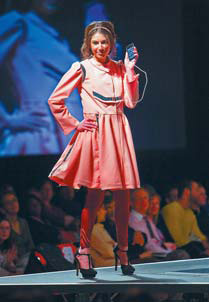Society
Nanotech's fashionable highlights
Updated: 2011-08-17 07:54
(China Daily)
|
At the 2010 Cornell Fashion Collective Show, student Heather Donsky models a solar jacket that uses conductive cotton threads to charge portable devices. Robert Barker / for China Daily |
Like many scientists, Juan Hinestroza is a self-professed fashion neophyte, more concerned with what's happening in the Petri dish than what's coming down the runway. His latest research, however, has awakened in him a growing awareness and appreciation of sartorial splendor.
Lately, Hinestroza has been wondering whether nanotechnology might be fashionable. It's a question he asks his students at Cornell University's department of fiber science and apparel design. The professor's answer - "yes" - is backed up by images of futuristic fabrics on display at Cornell's fashion collective spring show.
"The combination of science and design has so many wonderful applications," Hinestroza says during a media luncheon at Cornell's conference center in early August. "At Cornell University, we have designers and scientists working together."
At his lab in Ithaca, New York, Hinestroza's nanoscale science technology is being applied to textile science with some revolutionary results. Electrostatic self-assembly and atomic layer deposition techniques are being used to create multifunctional and customizable surfaces on conventional textiles.
Silver or gold-coated nanoparticles deposited on cotton creates fabric that can block the sun's harmful UV rays, render toxins harmless or provide improved thermal insulation.
"You could go outside in extreme temperatures with a single layer cotton shirt," Hinestroza says. "Other fabrics expel water."
Fabrics with embedded nanoparticles can detect counterfeiting devices because particles have "very unique signatures", Hinestroza says. "(Gold)-coated cotton fabrics have antibacterial properties and textiles coated with noble metals can detect explosives and drugs."
The technology could cause a revolution in several industries, from apparel manufacturing to dry-cleaning.
"(The fabric) makes people feel fresh," Hinestroza says, adding that "the Army could use underwear that can stand 30 days without a washing."
Colors can be attained by controlling the size and spacing of gold nanoparticles deposited onto cotton. A benefit is that unlike dyes, physical color doesn't fade when exposed to sunlight.
And Hinestroza says consumers can say goodbye to the common problem of trying to match two black garments from different brands or even the same collection. "This problem exists because the colors are chemical," he says. "If you use a physical color there's no problem. This could be very important to the tuxedo industry."
Asked when the technology will be widely used by the apparel industry, Hinestroza says, "We have some patents and people are licensing the patents."
Manufacturers could potentially charge more for garments made from the new textiles. "Clothing will have aesthetic value and will also be functional," Hinestroza says. "It will raise the value of crops. How much would you pay for clothing that could protect you from bacteria?"
New York Times

Specials

Star journalist leaves legacy
Li Xing, China Daily's assistant editor-in-chief and veteran columnist, died of a cerebral hemorrhage on Aug 7 in Washington DC, US.

Robots seen as employer-friendly
Robots are not new to industrial manufacturing. They have been in use since the 1960s.

Smurfs up in China
The movie remake of a classic 1980s cartoon series is expected to have special cross-generation appeal to Chinese filmgoers
